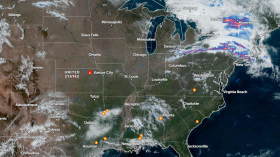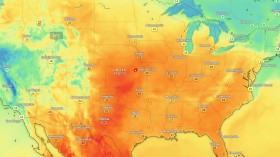Earth will soon find itself at the center of eager paparazzi when not one but two NASA spacecraft -- one studying Saturn and the other Mercury -- move into place July 19 and 20 to photograph the blue planet.
The image taken from the Saturn system by NASA's Cassini spacecraft will occur between 5:27 and 5:42 p.m. EDT on Friday, at which point NASA encourages individuals to step outside and wave.
At the time, Cassini will be nearly 900 million miles (roughly 1.5 billion kilometers) away from Earth, meaning our home planet will only occupy about a pixel. Though the picture does not represent the first time Earth will have been photographed from such a distance, it does mark the first time it will have been captured in natural color as human eyes would see it.
Furthermore, the event will be Cassini's first chance to photograph Earth with its highest resoluation camera since, due to position of the satellite, it will be able to point its camera in the direciton fo the Sun where Earth will be without damaging the spacecraft's instruments.
"Ever since we caught sight of the Earth among the rings of Saturn in September 2006 in a mosaic that has become one of Cassini's most beloved images, I have wanted to do it all over again, only better," Carolyn Porco, the Cassini imaging team lead at the Space Science Institute, said in a statement. "This time, I wanted to turn the entire event into an opportunity for everyone around the globe to savor the uniqueness of our planet and the preciousness of the life on it."
The Cassini Earth portrait is just part of a more extensive mosaic of the Saturn system to be taken while it is backlit by the Sun. By timing the photo just right, even the tiniest of ring particles will be highlighted, allowing scientists to see patterns within Saturn's dusty rings.
Processing of the Earth images is expected to take just a few days, while the processing of the full Saturn system mosaic will likely take several weeks.
Meanwhile, inspired in part by the Cassini team's enthusiasm, scientists overseeing the MESSENGER spacecraft reexamined the spacecraft's planned observations as it orbits Mercury only to discover that the Earth is coincidentally expected to appear in some images taken in a search for natural satellites around Mercury on July 19 and 20.
Those images will be taken at 7:49 a.m., 8:38 a.m. and 9:41 a.m. EDT on both days.
MESSENGER's photo session means that parts of Earth not illuminated in the Cassini images, including all of Europe, the Middle East and Central Asia, will appear illuminated in the images taken by the Mercury orbiter, which will also take a few days to process prior to release.
© 2024 NatureWorldNews.com All rights reserved. Do not reproduce without permission.

![Severe Thunderstorm Alert: Tornadoes, Damaging Winds and Hail Possible from Upper Ohio Valley to Northeast US [NWS]](https://1471793142.rsc.cdn77.org/data/thumbs/full/70161/280/157/50/40/severe-thunderstorm-alert-tornadoes-damaging-winds-and-hail-possible-from-upper-ohio-valley-to-northeast-us-nws.jpg)



